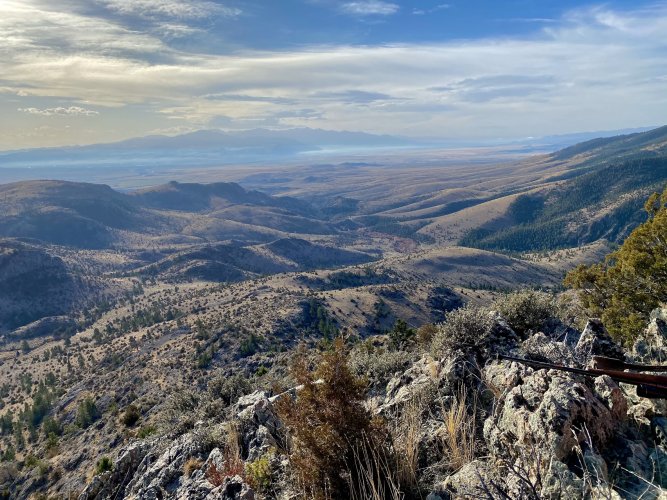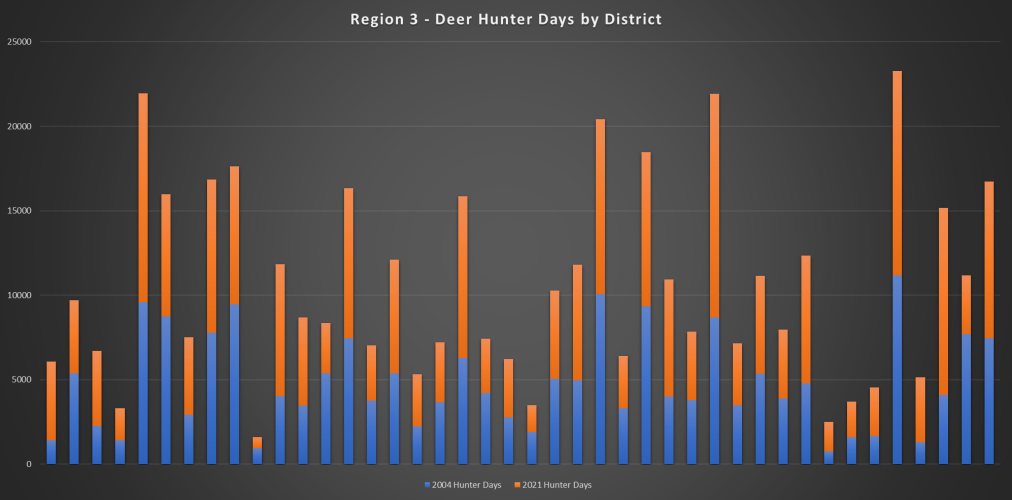Nameless Range
Well-known member
I think the varied anecdotes are really interesting, and it underscores one of the difficulties. Management changes should be local in consideration, but one cannot leave out the fact that old pressure is likely to shift and so considerations also need to be statewide.
I live in HD 335, a district in which hunter days on the landscape has nearly doubled in the last decade and a half. It’s superb deer habitat, and I can still go out and see 50 or 60 deer in a morning in half a dozen groups. Almost none of those will be bucks, and the ones that are will be teenagers in deer years. I believe this situation is a function of hunter numbers, bucks on general tags, and rut hunting. There are more elk in 335 right now than at any other time in my life.
20 miles south of me in HD 350, in the Whitetail Valley where I also grew up hunting, is some of the most superb deer habitat I’ve ever seen. As I child we’d see a hundred mule deer in a day, and often bucks that were interesting. That district has also seen a marked increase in hunter numbers and is roaded as hell. The deer situation there for both does and bucks is bleak, and the elk numbers are not high at all relative to the past. I believe the deer situation there is a function of the same stuff in 335 - too many hunters with too much access at too vulnerable a time.

Here's a chart of the hunting districts of Region 3 randomly displayed along the x axis, and the hunter-days reported spent hunting deer – both mule deer and whitetail. A hell of a difference 17 years makes. Truly, for most hunters, days spent hunting deer are just a subset of days spent hunting elk - a statistic that has grown at an even greater rate. I left out a few districts that existed in 2004 but not today, and vice-versa.

I know that many factors are at play, but the one in the chart is chief in my mind as one of the greatest drivers of mule deer population/class issues as most districts are not LE. What is causing mule deer issues is varied as so many have spoken to, but I do think a throughline for most of western Montana is pressure – both year round and during hunting season. If we are going to keep the pressure we should shift it to when bucks, as well as wintering does, are less vulnerable. I strongly believe in outsized local input, because I believe locals understand issues best, and so landscape based mule-deer working groups could be a great solution, but their ideas have to have teeth – we would have to be willing to experiment and implement different solutions, as well as assess those solutions for efficacy.
I live in HD 335, a district in which hunter days on the landscape has nearly doubled in the last decade and a half. It’s superb deer habitat, and I can still go out and see 50 or 60 deer in a morning in half a dozen groups. Almost none of those will be bucks, and the ones that are will be teenagers in deer years. I believe this situation is a function of hunter numbers, bucks on general tags, and rut hunting. There are more elk in 335 right now than at any other time in my life.
20 miles south of me in HD 350, in the Whitetail Valley where I also grew up hunting, is some of the most superb deer habitat I’ve ever seen. As I child we’d see a hundred mule deer in a day, and often bucks that were interesting. That district has also seen a marked increase in hunter numbers and is roaded as hell. The deer situation there for both does and bucks is bleak, and the elk numbers are not high at all relative to the past. I believe the deer situation there is a function of the same stuff in 335 - too many hunters with too much access at too vulnerable a time.

Here's a chart of the hunting districts of Region 3 randomly displayed along the x axis, and the hunter-days reported spent hunting deer – both mule deer and whitetail. A hell of a difference 17 years makes. Truly, for most hunters, days spent hunting deer are just a subset of days spent hunting elk - a statistic that has grown at an even greater rate. I left out a few districts that existed in 2004 but not today, and vice-versa.

I know that many factors are at play, but the one in the chart is chief in my mind as one of the greatest drivers of mule deer population/class issues as most districts are not LE. What is causing mule deer issues is varied as so many have spoken to, but I do think a throughline for most of western Montana is pressure – both year round and during hunting season. If we are going to keep the pressure we should shift it to when bucks, as well as wintering does, are less vulnerable. I strongly believe in outsized local input, because I believe locals understand issues best, and so landscape based mule-deer working groups could be a great solution, but their ideas have to have teeth – we would have to be willing to experiment and implement different solutions, as well as assess those solutions for efficacy.
Last edited:




